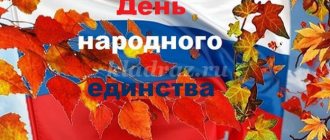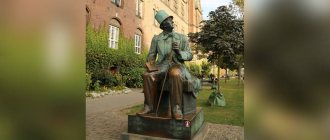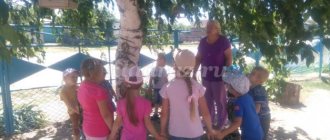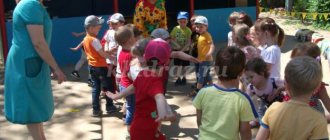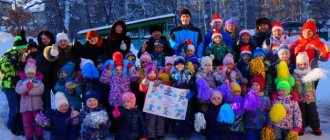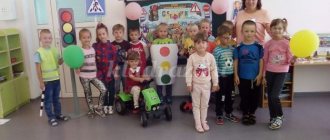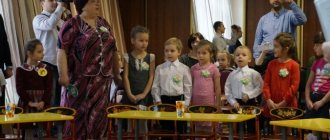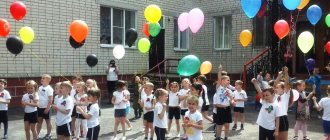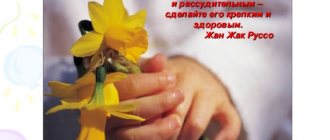Theater day in kindergarten. Entertainment scenario for older children
Educator: Hello kids, girls and boys! It's so good that there is a theater! Everything is wonderful here - gestures, masks, costumes, music, acting. Here our fairy tales come to life and with them a bright world of goodness! Educator: - Dear friends, today we will talk about the theater. Guys, tell me what you know about the theater? (Children's answers) I want to tell you a little about the history of the theater. The word "theater" means both the place where the spectacle takes place and the spectacle itself. The art of theater arose a long time ago. The performances lasted for several days. Spectators came to them, stocking up on food. Huge crowds of people were seated on raised platforms, and the action itself took place in an arena located directly on the grass. On March 27, we began to celebrate International Theater Day. And theater consists of actors and spectators, a stage, costumes, applause and, of course, interesting tales. Educator: Tell me, guys, what do you think is more interesting to live: with fairy tales or without them? (Children's answers.) Vasilisa the Wise gave you a gift in a magic chest so that fairy tales would be near us, be friends with us, and let us in. But it’s not easy to open it, you have to complete tasks. Shall we begin? Guess the riddles: A wooden boy walks to school with an ABC book, but ends up in a linen booth instead of school.
A girl appeared
In the cup of a flower, And there was that girl A little bigger than a marigold. Anyone who has read such a book knows a little girl.
Someone grabbed onto someone tightly:
- Oh, I can’t pull it out! - Oh, I'm stuck tight! Who is stuck so tightly? Maybe this …
— Guys, what other fairy-tale characters do you know? Name them.
Educator: - To become an artist you need to learn a lot, be able to do a lot. What do you think an artist should be able to do? (Speak well, understandably, clearly; breathe correctly; move beautifully, etc.) I invite you today to try to become artists. Let's imagine that we are in a theater workshop. Let's start by restoring proper breathing. Sit down, everyone, straighten your back, put your hand on your stomach. Breathing • Inhale through your nose and exhale slowly through your mouth. (1 time) • Inhale - exhale with the sound s-s-s-s-s (that’s how the wind whistles). • Inhale and exhale with the sound sh-sh-sh-sh (this is how trees make noise). Let's imagine that there is a feather on the palm of your hand. Inhale and exhale slowly so that the feather remains on the palm. And now we will do gymnastics for the lips and tongue. For lips.
• Pull your closed lips forward, like a pig’s heels;
stretch your lips into a smile without exposing your teeth. • Closed lips (patch) move up and down; then to the right, then to the left. For the tongue.
• “Injections.” With a sharp tongue, alternately touch the inside of the left and right cheeks. The lower jaw is motionless. • “Chatterbox.” Children talk with different intonations - Well done
Game “Theatrical warm-up”. You need to walk along a narrow path, pressing your backs to each other.
Educator: Do you like to read fairy tales? Do you want to become an artist? Then tell me, friends, How can you change yourself? To look like a fox? Or a wolf, a goat,
And without a costume, can children turn into, say, the wind, or rain, or a thunderstorm, or a butterfly, a wasp? What will help here, friends? (Gestures and of course the expression on our face - facial expressions) Let's show the fairy tale using gestures.
Logo fairy tale “Turnip” Turnip – show a circle with our hands; Grandfather - show the beard, join hands under the chin; Grandmother - show a handkerchief, join hands above your head in a house; Granddaughter - show the headscarf, join hands under the chin; Bug - show the ears, bend the thumb, middle and index fingers, and the index and little fingers are slightly bent; Cat - show the ears, bend the thumb, middle and index fingers, the index and little fingers are bent; Mouse - show a fist. Now together we will tell and show the logo fairy tale “Turnip”
Educator: There are, without a doubt, different moods, I will call it, try to show it. Game “Emotions” Show: sadness, joy, calm, surprise, grief, fear, delight, horror, happiness.
Game “Picture a Hero” Children, to the music, depict: • a princess • a hero • a fox • a bear
Educator: Now you are ready to become artists. Let's show the fairy tale "Teremok". (children show the fairy tale using Froebel’s “Teremok” play set) Educator: Well done! We completed the tasks. Did you enjoy completing the tasks? What did you like most? Let's try to open the magic chest! Hooray, it worked! (in the chest there is a sweet gift and a set for theatricalization of the fairy tale “Zayushkina’s Hut”)
Children's puppet theater. Preparation
It is always a big problem to choose what to give a child for his birthday. At our work, many spoke very highly of the “Little Genius” store, which is located in “Golden Babylon” (metro station Otradnoye, Moscow). We went there to get a gift. I immediately fell in love with puppet theater toys that fit on the hand. As a result, we bought a cat, a cat, a wolf, a bear and a crow. Already focusing on these characters, I sat down to write the script.
In the script for the children's puppet show, I clearly lacked characters. One character became a bun. I made it from a yellow ball with eyes and a smile, placing the ball on a stick. I found another character in the script “Sashuli’s Fourth Anniversary” on your website, he became Aibolit. Aibolit is no longer a puppet character; a costume had to be prepared for him. The costume required a white medical gown, a medical cap (I sewed a cross on it from red material), glasses, a fanendoscope (we had a toy one) and white face paint. I also bought the paint at the Little Genius store. I offered the role of Aibolit to Sasha’s grandfather. He was the only one who was familiar with his words in the role in advance, he had time to learn his words.
As last year, I printed out a fairy tale by role for each character, including the presenter, the version where his words were highlighted in bold; I made decorations from cardboard: two Christmas trees, two trees, a house; I prepared a screen: I placed a large cushion from the sofa on two chairs and covered it with red plush; I bought hematogen for all the children (guests were expected: Artem (5 years old), Artem (4 years old), Vanya (4 years old), Katya (2 years old) + our Sasha); printed the letter to Aibolit in large print.
The puppet theater script includes an episode of returning Sasha’s lost ring. On the eve of her birthday, Sasha lost her ring, dropped it through the open window of a minibus, and cried bitterly. I accidentally managed to buy exactly the same one. I wanted to surprise her. It is clear that in order to use this scenario in the general case, this episode must be removed. Even in the script, the children contact Aibolit via radio. These are children's walkie-talkies that work great when you need to communicate between two rooms in an apartment. Communication via walkie-talkie, if there is none in the scenario, can also be replaced with a phone call, whistle or other conventional signal.
Theater day in kindergarten. Senior group
A living wave makes noise, runs all over Moscow, Where is the wind, and trams, and the sun in the blue - Guys, today is theater day! - What is theater? Children's answers
— Who works in the theater?
Children's answers
- I suggest you check.
I will ask riddles, and you will solve them. RIDDLES: He walks around the stage, jumps, He laughs, he cries! If he portrays anyone, he will amaze everyone with his skill! And the type of profession has been formed for a long time -. Actor
He leads everyone, Thinks, runs, screams!
He inspires the actors, He directs the entire performance, Like a conductor of an orchestra, But his name is . Director
In the design of the face - Wigs, coloring, And hairpieces, and extensions, And stickers, masks - All this is needed for makeup, Everything is needed, without a doubt.
It is necessary for a make-up master - an artist -... a make-up artist
. There is a forest on the stage. There is a tower to heaven.
Scenery
In the cinema - a wide screen, In the circus - a manege or arena.
Well, in the theatre, an ordinary theatre, there is a special platform - ... Stage
- Well done! — Guys, name the types of theater? Children's answers
— Theater can be tabletop, puppet, shadow, finger.
The performers in these types of theater are puppets, and the actor voices the role of a particular character. There are theaters and dramatic ones, where the roles are played by the actors themselves. There are pantomime theaters. What does the word pantomime mean? Children's answers
- You and I know that there are opera and ballet theaters.
What kind of theaters are these? Children's answers
- What if the performance takes place on the street, on an equipped stage?
What is the name of this theater? Children's answers
- Correct.
This type of theater is called street theater because The action takes place on the street. But no matter what the theater is, it is impossible without an audience. — I suggest you remember the rules of behavior in the theater. Children's answers
- Very soon you and I will also go to the theater, where the guys from our group will perform a fairy tale.
How should we behave in the auditorium? Children's answers
- And now I invite everyone to relax a little.
PHYSICAL WORKSHOP “GRANDMOTHER YAGA” There is a hut in the dark forest (children are walking). Stands backwards (turn around). There is an old woman in that hut (they shake a finger). Grandmother Yaga lives (they shake the finger of the other hand), Her nose is hooked, her eyes are big (show) Like coals are burning (shakes her head) Wow, she’s so angry! (running in place) Your hair is standing on end (hands up). GAME “PANTOMIME” The child conveys any plot in action, etc., the rest of the children solve
the SHOW OF THE RUSSIAN FOLK TALE “RHYME”
Theater week in the middle group
Yulia Akimova
Theater week in the middle group
Goal: Development of children's abilities through theatrical art .
Tasks:
1. Arouse children’s interest in theatrical and gaming activities.
2. Give children an idea of the theater , theatrical professions , types of theaters .
3. Help create a joyful mood in children, develop imagination and creativity.
3. Improve children’s artistic skills in terms of experiencing and embodying the image, as well as their performing skills.
4. Activate children’s vocabulary, improve the sound culture of speech, intonation structure, and dialogic speech.
5. To develop experience in social behavior skills and create conditions for the development of children’s creative activity.
Monday
Morning
1. Conversation “What is theater ?”
Introduction to the concept of theater . Types of theaters (musical, puppet, dramatic, animal theater, etc. ). Give children an idea of the theater ; expand knowledge of theater as an art form ; introduce types of theaters ; cultivate an emotionally positive attitude towards the theater .
2. Exhibition of books by K. Chukovsky
3. Mini-performance “Masha and the Bears” ( bi-ba-bo puppet theater )
4. Reading fiction “Fedorino’s grief.”
Afternoon
1. Construction “We will build a large and small theater .”
2. Reading fiction “Geese and Swans”.
3. Psycho-gymnastics “Different faces”.
Encourage children to experiment with their appearance (facial expressions, gestures)
. Develop children's ability to switch from one image to another.
4. Artistic creativity. Drawing: “My favorite hero”
Learn to convey the image of your favorite character in a drawing; use material in the work at the request of the children; develop creative abilities.
5. Conversations with parents on the topic “ Theater and children ”
Tuesday
Morning
1. Conversation “Rules of conduct in the theater .”
Give children an idea of the rules of behavior in public places; to form a personal attitude towards non-compliance and violation of rules.
2. Conversation “My favorite hero”
.
Learn to talk about your favorite character.
3. Game Say your name in different ways.
4. Reading fiction “Zayushkina’s hut.”
Afternoon
1. Didactic game “Assemble a fairy tale” (from cubes)
2. Plot-role-playing game “We came to the theater ”
.
Arouse interest and desire to play (play the role of “cashier”
,
“ticketer”
,
“spectator”
); cultivate friendly relationships.
3. Re-enactment of the fairy tale “Zayushkina’s hut.”
4. Reading fiction “The Tale of the Fisherman and the Fish.” A. Pushkin.
Wednesday
Morning
1. Conversation “What kind of theater ?”
Introducing children to finger theatre , mitten theatre , shadow theater . Talk about theater on flannelgraph , on cups, about magnetic theater , flat theater , shadow theater , bi-ba-bo dolls and marionette dolls. Give children an idea about the features of these types of theaters .
2. Finger gymnastics “Toys”
Speech development, development of intelligence, spatial thinking, creative abilities of children.
3. Finger Theater “Let’s go for a visit”
.
To develop children’s ability to use finger theater in free activities; distribute characters.
4. Guessing riddles based on fairy tales.
Afternoon
1. Construction “Let’s build a stage.”
2. Role-playing game “ Theatrical Buffet ”.
4. Artistic creativity Drawing “We are drawing theater ”
5. Reading fiction: N. Suteev “Who said meow?
3. Psycho-gymnastics.
Learn to use intonations by pronouncing phrases sad, happy, angry, surprised. Learn to build dialogues. "Sad and happy puppy"
(based on the fairy tale by N. Suteev
“Who said meow?”
);
6. Recommendations for parents on choosing fiction for children.
Thursday
Morning
1. Introduction to theatrical professions : actor, director, make-up artist, costume designer, musician.
To form children's ideas about theatrical professions ; to intensify interest in theatrical art ; Expand words knowledge.
2. Children's games with sounding instruments.
Give children an idea of the musical design of performances.
3.Reading fiction: “Geese and Swans”
4. Games based on Russian folk tales “At the Bear in the Forest”, “Geese-Geese”
Afternoon
1 Independent activity of children in the theater corner
— magnetic theater “Repka”, “Teremok”
- finger theater "Repka"
— a game with rubber toys “Ryaba Hen” and “Kolobok”
Sketches with tabletop dolls based on well-known Russian folk tales.
2. Game “Come up with a funny and sad dialogue between the Mouse and the Bunny.” Goal: Develop communication skills; diversify intonation expressiveness; pay special attention to children's diction.
3.Reading fiction: “Winter quarters of animals”
Friday
Morning
1 Quiz: “Remember the name of the fairy tale and the name of the main character”
2. Artistic creativity. Drawing: “The bun rolled along the path”
3. Dramatization of the fairy tale “Teremok”.
Develop the ability to build dialogues between characters in imaginary circumstances. Develop children's coherent speech and expand their figurative speech. Monitor the expressiveness of the image.
4.Reading fiction: “The Cockerel and the Beanstalk”
,
Afternoon
1. Didactic game “Assemble a fairy tale hero” (from cubes)
2. Artistic creativity Drawing “Let’s color the fairy tale characters”
3.Reading fiction: “The Three Little Pigs”
.
Staging puppet shows. Observations
- As it turned out, having the text of the roles in this form, when each character has his words in bold, it is possible to stage any performance with a script unknown in advance without preparation. This is much more convenient than the option where the author is indicated at the beginning of each replica. Everyone did a great job in their roles, even though they were seeing the text for the first time. They played like real actors and without a single rehearsal.
- As it turned out, the puppeteers held the puppets a little low. The screen for the puppet theater was quite high, the children sat on the ottoman - low, sometimes they even stood up to properly see what was happening. That is, the hand with the doll needs to be stuck out higher. I think there will be nothing terrible if the hand is slightly visible, it will be much better than children seeing only the doll’s head.
- Riddles that rhyme with wrong answers were a bit challenging for little ones. They are suitable for older children. It’s good that the characters repeated each such riddle according to the script several times, and the grandmother actively helped the kids.
- When I wrote the script for the puppet show, it seemed to me that it was very long. But in the end it turned out that it was not. If you stage such a play for older children, you can lengthen the script by one and a half times. The length was just right for our audience.
- There is no need to make decorations at all. There were a lot of people behind the screen, everyone was crawling on their knees. It was very difficult for me to move the scenery properly. In the end, the house, which was made at an angle, fell apart, people started fixing it and almost missed their “exit.”
- But overall, in my opinion, both the audience and the actors liked the performance. Adults sometimes have fun playing too.
Kosyakova Tatyana
